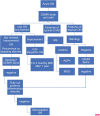Approach to optic neuritis: An update
- PMID: 34427197
- PMCID: PMC8544067
- DOI: 10.4103/ijo.IJO_3415_20
Approach to optic neuritis: An update
Abstract
Over the past few years, there has been remarkable development in the area of optic neuritis. The discovery of new antibodies has improved our understanding of the pathology of the disease. Antiaquaporin4 antibodies and antimyelin oligodendrocytes antibodies are now considered as distinct entities of optic neuritis with their specific clinical presentation, neuroimaging characteristics, treatment options, and course of the disease. Similarly, there has been a substantial change in the treatment of optic neuritis which was earlier limited to steroids and interferons. The development of new immunosuppressant drugs and monoclonal antibodies has reduced the relapses and improved the prognosis of optic neuritis as well as an associated systemic disease. This review article tends to provide an update on the approach and management of optic neuritis.
Keywords: Myelin oligodendrocytes; multiple sclerosis; neuromyelitis optica; optic neuritis.
Conflict of interest statement
None
Figures






References
-
- Chopra JS, Radhakrishnan K, Sawhney BB, Pal SR, Banerjee AK. Multiple sclerosis in North-west India. Acta Neurol Scand. 1980;62:312–21. - PubMed
-
- Singhal BS. Multiple sclerosis and related demyelinating disorders in Indian context. Neurol India. 1987;35:1–12.
-
- Bhatia M, Behari M, Ahuja GK. Multiple sclerosis in India:AIIMS experience. J Assoc Physicians India. 1996;44:765–7. - PubMed
-
- Verma N, Ahuja GK. Spectrum of multiple sclerosis in Delhi region. J Assoc Physicians India. 1982;30:421–2. - PubMed
Publication types
MeSH terms
Substances
LinkOut - more resources
Full Text Sources
Miscellaneous

